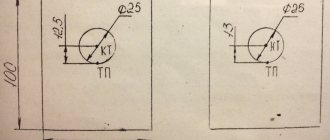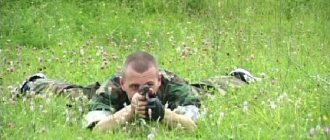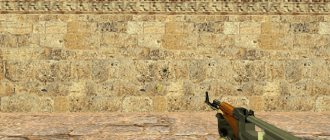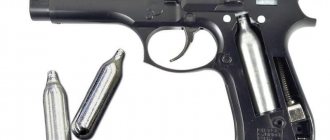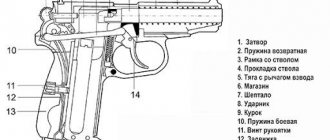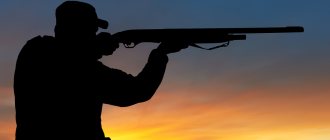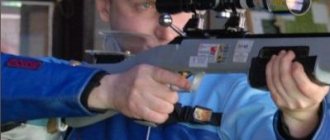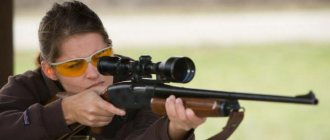In Russia, a civilian pistol is an exclusively sporting weapon, and this is one of the reasons for the popularity of shooting sports. But before you join a sports club and buy a weapon, you need to master the basics of proper handling of it.
An educational program on the technique of shooting with an air pistol and firearms was conducted by Dmitry Ostrovsky, a professional in the field of shooting sports and co-owner of the weapons company SWC . This company specializes in the manufacture and tuning of sports pistols and carbines. For example, an excellent model for the standard class is SP-0001.
This is a Colt based pistol, chambered in .40 S&W with a magazine capacity of 19 rounds. The weight of the moving parts is precisely selected, and the trigger mechanism of SWC's own design allows you to adjust the force on the trigger from 120 g.
A special feature of the SP-0001 is the front sight mounted on the barrel, which ensures quick restoration of aiming after a shot.
How to learn to shoot a pistol correctly
Standard pistol kit
Before starting training, you need to purchase sufficient spare parts for the pistol. Watch a video review of air pistols here.
Needed:
- Holster.
- Spray can (for gas pistols).
- Shop.
- Muffler.
- Bullet holder.
- If you need quick access to the pistol (when storing it in a car or at home), purchase a pistol holder.
Devices for improving weapon performance
Devices that help improve the performance of the pistol can be acquired gradually, but it is best to take the necessary items in advance:
Night vision scope for pistol
- Night sight. Necessary when trying to hit a target in the absence of proper lighting. The disadvantage of this device is its insufficient efficiency in dim lighting conditions or at dawn. It does not have enough power to fully illuminate the space when the reflection of sunlight appears, when natural light is not yet sufficient. When there is practically no light or there are single sources of light (lanterns), the sight helps to perfectly see everything that is happening several meters ahead.
- Tactical underbarrel flashlights. They serve not only as bright and targeted lighting, but also as an additional method of gentle defense. If you direct it into a person's eyes with a sharp movement of the hand, the enemy will experience short-term loss of vision. This element makes the weapon heavier. You should purchase high-quality models of this invention, then there is no risk of it breaking.
- Trim adjustment. It can be done for each pistol by adjusting the hook or by shortening the length of its stroke. This improvement will help you hit targets much more accurately. With this modification, a larger sequence of shots is achieved. It is necessary only when the trigger is moved too tightly or it is necessary to hold it for a long time until it stops. In other cases, no modernization is required.
- Rubber lining on the handle. The gun is made more convenient, it is easier to hold in your hands, there is no risk of slipping or slightly tilting. Such accessories are especially useful for people with massive palms. You need to make sure that they do not have the ability to move on their own, otherwise the shot may be inaccurate. When using such coatings, additional care will be required; you need to regularly clean out the dirt that accumulates under them.
Safety and Preparation
When firing a pistol, you should adhere to basic safety precautions:
Pistol shooting
- who have not completed a training course or are not familiar with the rules for operating a specific weapon are not allowed to fire a pistol Every person firing from any pistol must know basic safety measures and be familiar with the rules for assembling and disassembling weapons and the operation of the main structural mechanism.
- When shots are fired at targets, strangers must not be allowed into the designated area. If a specific place is not specifically intended for shooting, then before using a weapon you should make sure that people and animals cannot pass within several hundred meters.
- The magazine may contain only those cartridges that are suitable for shooting in all respects. You cannot use cartridges that are taken from a batch where at least one copy misfired. Also prohibited are bullets that are not intended for the type of handgun that the user currently owns.
- It is prohibited to use a faulty pistol for shooting.
- If the fuse is turned off, it is necessary to ensure that the flag is lowered all the way down. If the flag is not fixed in any way, shooting is prohibited.
- It is impossible to cover the barrel with your hand or plug it with foreign objects, as it can become deformed and, under strong stress, explode.
- If there is a risk of sand or other significant contaminants entering the bore, it must be opened, carefully inspected and cleaned. If you don’t have time to do this, you just need to shake the weapon vigorously so that the excess contents spill out. An easy and quick way to clean the inside of the barrel: wiping with a rag attached to a cleaning rod.
- When reloading a weapon, the muzzle should be pointed in the direction where the person intends to shoot.
- Before carrying out a full inspection of the contents of the pistol structure, disassembling, cleaning and reassembling, as well as after finishing shooting, you should make it a rule to unload the weapon.
- If it is necessary to transfer the pistol from combat readiness to field conditions, you need to activate the safety and make sure it is reliable. If possible, the muzzle of the weapon is directed in the direction that is safest for the owner and the people around him.
- To avoid mechanical injury, you should control the position of your hands during shooting. Fingers should not get into the shutter rollback zone.
- The pistol should only be stored with the safety switch on in places that are safe and secure from children.
Watch the video:
Part 4. Pistol shooting
Control your breathing
Just before you fire the gun, that is, after you have taken careful aim, you will need to take a deep breath and hold it. Calm your body. Looking at how the sights (front and rear sights) move, you will notice that with their movements they outline a small figure in the shape of a number eight. It has to do with your heartbeat. Start squeezing the trigger when the scope reaches the bottom of the figure eight, and when the scope is at the aiming point, finish pulling the trigger.
The time between the moment you hold your breath and the moment you pull the trigger should be short. However, you should not rush or fuss - this will not lead to anything good.
Pull the trigger
Each firearm requires a different trigger pull—the trigger pressure required to fire a shot differs from weapon to weapon. Before you load your pistol, it's a good idea to dry-fire it (point the unloaded pistol down and pull the trigger until you hear a click). This will help you know at what minimum pressure the gun fires.
When you are ready to fire, slowly pull the trigger in one smooth, controlled motion. A common reason for inaccurate shots when shooting a pistol is the so-called. “waiting for recoil” (the shooter jerks the pistol forward, expecting that it is about to fire). It may seem counterintuitive, but for the most accurate shots, try to let the recoil “surprise you” rather than trying to predict when it will happen.
Completion - descent support
Every sport has an “end stage,” and target shooting is no exception. When you pull the trigger, the gun will fire. This means it's okay to relax, but don't suddenly let go of the trigger or weaken your concentration, stance, or hands. Keep calm. Release the trigger slowly and then when you hear the click, take a breath and prepare for the next shot.
- Taking things one step at a time improves accuracy and reduces bullet spread, just like for a golfer or tennis player (each shot follows the previous one).
Practice shooting a pistol several times in a row
Take your time between shots. There's no hurry. It is better to make a few accurate hits than many unsuccessful ones. Practice on the range to improve your skills. Don't turn money spent on ammunition and training into empty words.
Unload your weapon and double-check it to make sure it is EXACTLY fully unloaded
While the pistol is still in the ready-to-fire position, return the safety to its place (if your pistol has one) and remember to keep the pistol pointed down while you unload it. For revolvers it's a little different: check the cylinder to make sure there are no rounds in it or remove any that are left there.
In the case of a semi-automatic pistol, remove the magazine and then retract the bolt to remove any cartridge that may be left in the chamber.
How to Shoot a Pistol: Questions and Answers
Tell me, can I get injured the first time I use a revolver?
Keep your fingers away from the front of the cylinder - this is where hot powder gases escape when firing this type of pistol. Do not point the gun at yourself or anyone else, and do not point the gun at anything you are afraid of breaking or destroying. Don't shoot at anything that might make you angry, such as an animal (and don't shoot at live targets anyway - it's inhumane).
How do I know which of my eyes is dominant?
Hold your hands in front of you, palms facing away from you, and make a small triangle by placing one thumb on top of the other and the fingers of one hand over the fingers of the other. Now look at a distant object through this triangle. Close one eye. If you can still see the object, the eye that remains open is your dominant eye.
I'm only 11 years old, but I already want to shoot a pistol. Do I need parental permission?
It is entirely up to your parents since you are a minor and under their guardianship. Try to find classes/trainings available for teens in your area and ask your parents if you can take a gun safety course. If you complete the course well, it will show them that you are serious and responsible enough to handle a gun.
Should you cock your weapon before every shot?
For a semi-automatic pistol, you only need to cock the bolt if there is no round already in the chamber. In most cases, this will only happen after you load a new magazine, since when you fire, the semi-automatic pistol will place the next round in the chamber for you.
If I have hardly ever shot a pistol before, should I buy one? Does this require prior practice?
It is better to practice at the shooting range and gain a little theoretical knowledge before buying a weapon. In most cases, before purchasing, you will have to take a test to see if you can handle the gun.
How to properly eliminate a delay when firing a pistol (for example, if a cartridge is stuck in the chamber)?
First, remove the magazine, then pull the bolt back to pop out the stuck cartridge. Doing these steps in this order prevents other rounds from entering the chamber and causing even more problems.
Can you pull the trigger with two fingers?
Yes, but it is strongly not recommended. By using two fingers at once, you weaken your grip and therefore reduce your ability to control recoil. If you have to use two fingers to fully pull the trigger, make sure you have a firm grip on the gun and be extremely careful.
What else do I need to know about revolvers and how to shoot them?
Keep your fingers away from the front of the cylinder (closer to the barrel) when you shoot. Hot powder gases burst out at this point and can burn your fingers. Be careful not to put your fingers between the cartridge and the trigger. Getting hit on the finger by a striker is very painful.
Will the shutter become less tight over time?
Yes, after a certain number of shots from an automatic pistol, the bolt “explodes”. It will become more convenient and easier to use.
My mom has a 9mm pistol. Can I shoot someone with this gun if they break into a house?
No way! You should immediately leave the house and call the police, and not rush with a weapon (which you do not yet know how to handle) at the burglar. Trying to resist an attacker is dangerous. The things in your house are not worth your life.
Is it safe to aim at people if I have the safety on the gun?
No, it is NEVER safe to aim at someone, even if the gun is on safety. Accidents happen very often, and unless you want to hurt or kill someone, don't point a gun at anyone.
Do I need to clean up the range after shooting my pistol?
This depends on the firearm you are using and where you are shooting. Most ranges require you to clean up the shell casings. This is easy to do with a revolver because all the spent cartridges remain in the revolver.
How to shoot a pistol: Helpful tips
- When you grip the gun, make sure your index finger is not on the gun's mechanisms, outside the trigger guard, and parallel to the slide, not at an angle.
- Always be prepared for recoil from your weapon, regardless of its type, but don't try to anticipate it or your shots will miss.
- One hour of instruction makes a significant contribution to your pistol shooting skill. You will learn how to train correctly. This will allow you to improve your accuracy and speed rather than burning through hundreds of rounds without any improvements, which will tire you out and only reduce your accuracy.
- If you are using a pistol with a lot of recoil, be careful not to let it hit you in the face.
- It is important to practice regularly and consistently. A great practice is dry shooting. In this case, the weapon is not loaded, but special blank cartridges should be used to prevent damage to the pistol from the trigger, which simply fires. Such cartridges are widely available, but most of them are limited in the number of uses. When dry training, still carefully check that the weapon is unloaded, even if you remember that the ammunition is in another room. Aim at the basement wall or earthen rampart, but not at the door or the place where random passers-by might be.
- Never forget to protect your eyes and ears.
- Proper safety precautions are extremely important. You may find that experienced gun owners are very security conscious. They know that gun handling habits that are only 99% safe are a recipe for disaster. Here we need a solid hundred!
- Clean your pistol after you finish shooting. Never leave it in the safe for long unless you have thoroughly cleaned it, inside and out.
How to Shoot a Pistol: Warnings
- Treat the weapon as if it is loaded. ALWAYS!
- In most European countries and Canada, you are required to have one or more licenses to possess firearms and ammunition.
- You may need a license to carry a handgun in your car and in a holster.
- The instructions in this article apply to target shooting. Other types of shooting, such as hunting and sport shooting, require different techniques. If you are not familiar with them, it is best to hire an instructor. Not knowing the proper techniques for a given situation will be potentially dangerous.
- Pistols are inherently dangerous (due to their design). Improper use of the gun and, in general, any carelessness when using it can lead to property damage, personal injury and death. Careless handling of a gun has sent many to prison for negligence. Be careful and careful when using the gun.
- Handguns are illegal for most civilians in many countries. Please check the law in your country carefully before following the steps above.
- Most ammunition contains lead cores, and lead is a toxic heavy metal. Use copper jacketed bullets to eliminate or reduce the presence of lead in the air when shooting. Always wash your hands after firing or disassembling a pistol.
Original article: How to Shoot a Handgun
Aiming techniques and rules
Many people choose a shooting range to practice their skills. Rarely does one find the most convenient platform. A shooter, especially a beginner, will be constantly disturbed by strangers who either shoot themselves or watch the success of others. You can learn to shoot a pistol through courses or from a friend who has professional skills. Many people are faced with the problem of weapon power; material on how to increase the power of an air pistol will help with this. Read about how to repair an air pistol here. When using a weapon, never forget about responsibility and the law on the use of firearms by the police.
Watch the following video for pistol shooting techniques:
The calmest and most comfortable place is a large clearing, where neither people (vacationers) nor animals go. Such a place should be chosen carefully so that you can come and practice shooting at any time.
It is advisable to start learning new rules and techniques for making shots with quality stretching. This exercise is not visually related to weapons, but it helps strengthen muscles and make the body more stable.
To be able to hit the target after each shot, you must first feel the operation of the weapon and get used to its sight. To do this, you should not immediately shoot at long distances. It is even possible to measure a minimum distance of 15 m.
If the bullets do not reach the target or a certain more limited area, it is necessary to constantly repeat attempts until the result is obtained. Then you can move to a longer distance.
Shooting target
Air pistol shooting technique
The technique of shooting an air pistol will only be mastered when a person understands the features of his own weapon. There is often a difference between where a person aims and where the bullets land. You also need to know how to aim correctly. If you accurately determine this distance, there will be no problems with the accuracy of the projectiles hitting. You need to understand that shooting with a pistol is not sniper training, so you shouldn’t get upset about frequent mistakes.
If a person has recently started shooting, it is advisable at first not to move further than 25 meters from the target. This will help you enjoy your success and learn to hit even those targets that are less than 30-50 cm in diameter.
During the first lessons, the shooter will be able to hardly hit an object the size of a human figure. In the future, you are allowed to reduce the target and move away from it, improving your skills.
When shooting a pistol, you must always follow the safety requirements when handling weapons.
When handling weapons, you also need to know the rules of first aid for injuries, more on them later.
Read about what safety measures exist when shooting at:
The procedure for correct shooting with a Makarov pistol (PM)
The techniques and rules for shooting from a Makarov pistol are practically no different from the standard ones. All features are determined by the structure of the weapon. A limitation is imposed on the duration of rapid fire. You can shoot correctly and successfully from a Makarov pistol until the recoil spring overheats.
Watch the video:
Before firing shots from a PM pistol, you need to release the rather tight safety. Self-cocking requires the use of force when pressing the trigger.
This feature protects against involuntary shots. The weapon is light, comfortable to carry and hold at arm's length, so there are no problems with aiming.
For fans of high-speed shooting, the Drozd pneumatic gun is suitable. In addition, popular models are the Makarov MP 654k air pistol, Colt 1911, PMM pistol and Walter pistol.
How to handle weapons (safety precautions)
When you pick up a weapon, first point the barrel in a safe direction (at a wall, at the floor). Disconnect the magazine and check to see if there is a round in the chamber. Do not touch the trigger with your finger. This behavior should become your habit when handling any weapon.
If you are involved in shooting sports, are fond of hunting, or are forced to carry weapons on duty, the first thing you must clearly know and follow is the rules for safe handling of weapons. Don't take guns lightly. Remember that the rules for handling weapons are written in blood. Probably, any reader will remember cases when people, not knowing or not following safety rules, accidentally injured or even killed each other. This can happen while hunting, in shooting sections, or in the service. Injury caused by careless handling of a weapon can lead to a chain of other troubles and troubles: a criminal case, family breakdown, removal from a position, etc.
If you have a weapon in your hands and you do not follow safety rules, then a tragedy can happen at any moment.
To prevent this from happening, it is necessary to constantly practice the skills of safe handling of weapons. A man with a weapon in his hands is a shooter. The shooter is required to undergo practical training in the rules of safe handling of weapons. An untrained shooter holding a gun is the same as an untrained driver behind the wheel of a car.
The safety rules are briefly expressed in the Shooter's Code for Practical Shooting:
1. I will always treat the weapon as if it were loaded.
One shooter told me a story that I still can't get out of my head. This happened in a military unit. A young family lived in the garrison, consisting of an officer father, mother and five-year-old son. One day dad came home from work. There had been shootings during the day, and he was very tired. As always, he was greeted at the door by his joyful little son. The father took the pistol out of the holster, removed the magazine from it and let the boy play with the weapon. Occasionally he did this. The father watched with pleasure his growing son and thought: “Let the boy get used to weapons.” The inspired boy ran around the apartment, playing war, aiming at invisible enemies and trying to pull the trigger. But the index finger was weak, and he could not press the trigger. Then the boy sat down on the sofa, pointed the muzzle of the gun at himself, put both thumbs on the trigger and pressed as hard as he could. The bullet hit the child's head. After the shooting, the father did not remove the cartridge from the chamber. The grief was unbearable for the family. The couple separated. The officer left military service and began to drown his sorrows in wine. Due to a violation of a basic safety rule, an irreparable tragedy occurred.
Dear shooters! If you have picked up a weapon for any purpose, you need to do the following procedure: point the barrel of the weapon to a safe place (wall or floor); disconnect the magazine and check if there is a cartridge in the chamber - to do this, pull the bolt twice. You should always check your weapon, even if you are sure that it is unloaded. After some time, this procedure will become a habit. This is a very useful habit.
2. I will never point a gun where I don’t want to shoot.
When removing a weapon from a holster, from a safe, from a case, etc., always watch the direction of the barrel: the barrel should under no circumstances be pointed at people, animals, or in any unsafe direction. You must always control where the muzzle of your weapon is pointed, regardless of whether it is loaded or not (see Rule 1). This should become your habit. If someone in your presence twirls weapons, juggles, or jokingly takes aim at people, calmly and seriously ask them not to do this again. Explain that it is not customary to do this.
During training or hunting, when you overcome obstacles with a weapon in your hands or open a door while performing an exercise, be careful. Never point a weapon at yourself or place your hands or feet under the barrel of a weapon, even if you think the weapon is unloaded. This should also become a habit.
3. Before I shoot, I always check what is in front of and behind the target.
When you shoot at a target, do not forget that the bullet, having pierced the target, does not lose its destructive power and can end up where you did not expect. Always be in control of the situation at the shooting range. Analyze the trajectory of a bullet, the movement of people, animals and equipment. Consider the trajectory of a possible rebound.
4. I will never touch the trigger with my finger until the barrel is pointed at the target.
This is one of the most important rules for safe handling of weapons directly when shooting. Do not touch the trigger with your finger unless you are aiming and shooting. When removing a weapon from a case or safe, when reloading, when moving, when changing the shooting position, the index finger must be outside the trigger guard. Get used to this from the first minutes of your acquaintance with the weapon.
The fourth rule sometimes evokes a skeptical grin from “old fighters” who are confident that they are in complete control of themselves and can afford to always keep their finger on the trigger. However, it is failure to comply with the fourth point of the safety rules that most often leads to an accidental shot.
If during the exercise the shooter constantly keeps his finger on the trigger, then a sharp external stimulus can cause involuntary contraction of the hand muscles and flexion of the index finger. The result of this is a useless shot, which can lead to disqualification from competitions, or even send the shooter to the dock or hospital bed. Therefore, during training and practical shooting competitions, instructors, judges, and shooters pay great attention to the position of the index finger. You point the weapon at the target - put your finger on the trigger, remove the weapon from the target - remove your finger. After firing approximately 1000 shots or several days of training, control of the index finger becomes automatic. This is an important aspect of gun safety and culture.
Quite recently, one of my acquaintances, an employee of a well-known special forces unit, told a story that happened in their group during their next business trip to a “hot spot.” An armored personnel carrier arrived at the group’s location after completing the next task. The employees, tired after a difficult route, began to jump off the “armor.” The officer who jumped last had an AK with a cartridge in the chamber in his hands, his finger on the trigger. Without bothering to put the weapon on safety or remove his finger from the hook, the employee jumped to the ground. At the moment of landing, he tripped over something and involuntarily pulled the trigger. A burst of machine gun fire cut through the evening silence. The result of violating this “unimportant” safety rule: two comrades were killed and several were wounded.
Of course, not a single shooter in the world is immune from trouble. An accidental shot always happens unexpectedly. There is a good chance that when dealing with a gun, you will at some point fire an accidental shot. But if you make it a habit to ALWAYS follow the rules of safe handling of weapons, then this shot will not harm anyone.
We must remember that weapons were originally intended for destruction and destruction. You cannot allow yourself jokes and careless, careless handling of him. Weapons require respect and care - this is another of the most important aspects of the culture of handling weapons. An athlete juggling his pistol looks stupid and undignified. A shooter who carefully handles a weapon and then quickly and accurately hits targets always evokes the admiration and respect of others, while an irresponsible “juggler” can only cause bewilderment.
Author: Vitaly Kryuchin/Practical shooting/2009
Also read:
What is the difference between a magazine and a clip?
Disassembly and assembly of AK-74
Step-by-step shooting instructions
Hit the target from a standing position
Shooting from a standing position
- Feet shoulder width apart.
- Turn left. The right leg does not move, but the left leg moves back to a state that is comfortable for the person. This stand is designed for right-handed people.
- For left-handed people, it is advisable to perform these steps in a mirror order.
- Remove the pistol from the holster after first unfastening its cover.
- Extend your arm straight to the level of the target. Try to relax the muscles a little, but fix the position well. (This action should be performed with the hand you are going to shoot with.)
- The second (left for right-handers) is in a free position; you can put it behind your back.
Aim accurately from your knees
The photo shows shooting from the knee
- The left leg is brought behind the right so that they form a clear straight line. The approximate distance between them is equal to the width of the shoulders.
- Lower yourself to your left knee as if you want to squat. At the same time, use the heel of your left foot for support. Keep your feet absolutely straight in this position, the toes of your shoes should be pointed towards the target.
- Remove the pistol from the holster and remove the safety.
- In this position, you can actively move, as if springing on bent legs. Mastering the technique requires practice.
How to aim while lying down
- Place your right foot forward, slightly tilting it to the right.
- Feed the body straight.
- Sit down on your left knee and lean on your hand on the same side. The emphasis should be maintained, focusing the tension on the area of the forearm and the femoral area of the leg.
- Lie down on your left side and take a comfortable position on your stomach.
- Turn your body in the direction where the target is located, leaning on your supporting arm and leg. This position ensures that the shooter is slightly turned sideways towards the target.
- The right hand goes parallel to the surface of the earth. It serves as a support for the head. Position yourself so that you can aim and shoot comfortably.
- When taking the correct position, a person feels smooth support and no discomfort when aiming and making shots.
For information on which air gun is the most powerful of those allowed, see here. Read about sports pistols for practical shooting here. Comparison of pistols, you can find out from the material about the rating of air pistols, more about it below.
Stance and grip
Stance is the basis of a stable position and an important component of an accurate shot. There are several shooting stances, the main one of which looks like this:
- legs slightly wider than shoulders and slightly bent;
- the left foot (for left-handed people - the right) is slightly forward;
- the body is turned towards the target;
- shoulders relaxed and lowered;
- hands are straight when aiming and shooting.
The grip is formed first with one, dominant hand:
- index finger - on the frame, outside the trigger guard, in the direction of the barrel;
- thumb - at the same level on the other side;
- the remaining 3 fingers tightly grip the handle.
The 2nd hand lies on top of the leading one so that the index finger is tightly pressed from below to the trigger guard, and the thumb is above it and directed towards the target.
Additional Tips
Shooting instructor tips
- When conducting a battle, you must not let your ammunition run out completely. Get used to this at the learning stage. When the number of bullets comes to an end, reload the magazine.
- To ensure timely protection or surprise attack, practice snatching the weapon from the holster in one sharp movement and instantly prepare to fire.
- Even when shooting very quickly, try not to pull the trigger thoughtlessly, and if you need an instant response, check the accuracy and speed of use of the weapon.
- Shooting a pistol in public places unless absolutely necessary is prohibited. Only designated areas may be used for training.
- To learn to shoot a pistol accurately, you need to constantly practice. If you fail, you can reduce the distance from the goal. Upon successful completion of training, regular training is required.
